ESP FIAT FIORINO 2012 Owner handbook (in English)
[x] Cancel search | Manufacturer: FIAT, Model Year: 2012, Model line: FIORINO, Model: FIAT FIORINO 2012Pages: 210, PDF Size: 4.9 MB
Page 116 of 210
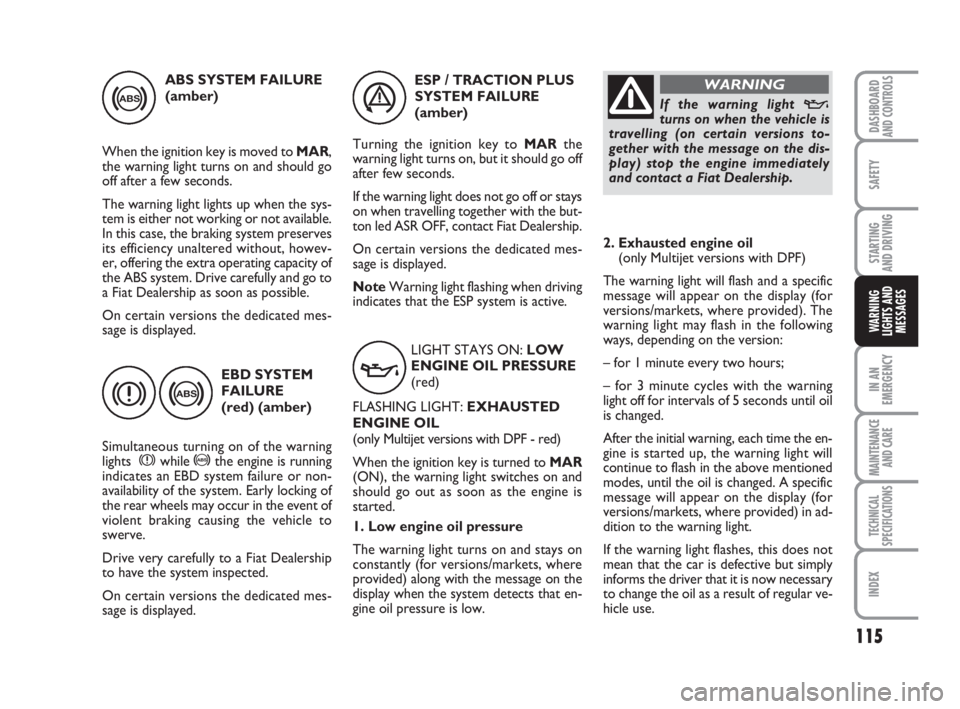
115
SAFETY
IN AN
EMERGENCY
MAINTENANCE
AND CARE
TECHNICAL
SPECIFICATIONS
INDEX
DASHBOARDAND CONTROLS
STARTING
AND DRIVING
WARNING
LIGHTS AND
MESSAGES
ABS SYSTEM FAILURE
(amber)
When the ignition key is moved to MAR,
the warning light turns on and should go
off after a few seconds.
The warning light lights up when the sys-
tem is either not working or not available.
In this case, the braking system preserves
its efficiency unaltered without, howev-
er, offering the extra operating capacity of
the ABS system. Drive carefully and go to
a Fiat Dealership as soon as possible.
On certain versions the dedicated mes-
sage is displayed.
EBD SYSTEM
FAILURE
(red) (amber)
Simultaneous turning on of the warning
lights
xwhile >the engine is running
indicates an EBD system failure or non-
availability of the system. Early locking of
the rear wheels may occur in the event of
violent braking causing the vehicle to
swerve.
Drive very carefully to a Fiat Dealership
to have the system inspected.
On certain versions the dedicated mes-
sage is displayed.
>
x>
v
LIGHT STAYS ON: LOW
ENGINE OIL PRESSURE
(red)
FLASHING LIGHT: EXHAUSTED
ENGINE OIL
(only Multijet versions with DPF - red)
When the ignition key is turned to MAR
(ON), the warning light switches on and
should go out as soon as the engine is
started.
1. Low engine oil pressure
The warning light turns on and stays on
constantly (for versions/markets, where
provided) along with the message on the
display when the system detects that en-
gine oil pressure is low.ESP / TRACTION PLUS
SYSTEM FAILURE
(amber)
Turning the ignition key to MARthe
warning light turns on, but it should go off
after few seconds.
If the warning light does not go off or stays
on when travelling together with the but-
ton led ASR OFF, contact Fiat Dealership.
On certain versions the dedicated mes-
sage is displayed.
NoteWarning light flashing when driving
indicates that the ESP system is active.
áIf the warning light vturns on when the vehicle is
travelling (on certain versions to-
gether with the message on the dis-
play) stop the engine immediately
and contact a Fiat Dealership.
WARNING
2. Exhausted engine oil
(only Multijet versions with DPF)
The warning light will flash and a specific
message will appear on the display (for
versions/markets, where provided). The
warning light may flash in the following
ways, depending on the version:
– for 1 minute every two hours;
– for 3 minute cycles with the warning
light off for intervals of 5 seconds until oil
is changed.
After the initial warning, each time the en-
gine is started up, the warning light will
continue to flash in the above mentioned
modes, until the oil is changed. A specific
message will appear on the display (for
versions/markets, where provided) in ad-
dition to the warning light.
If the warning light flashes, this does not
mean that the car is defective but simply
informs the driver that it is now necessary
to change the oil as a result of regular ve-
hicle use.
111-122 Fiorino GB 1ed:111-122 Fiorino GB 1ed 2-12-2009 16:18 Pagina 115
Page 135 of 210
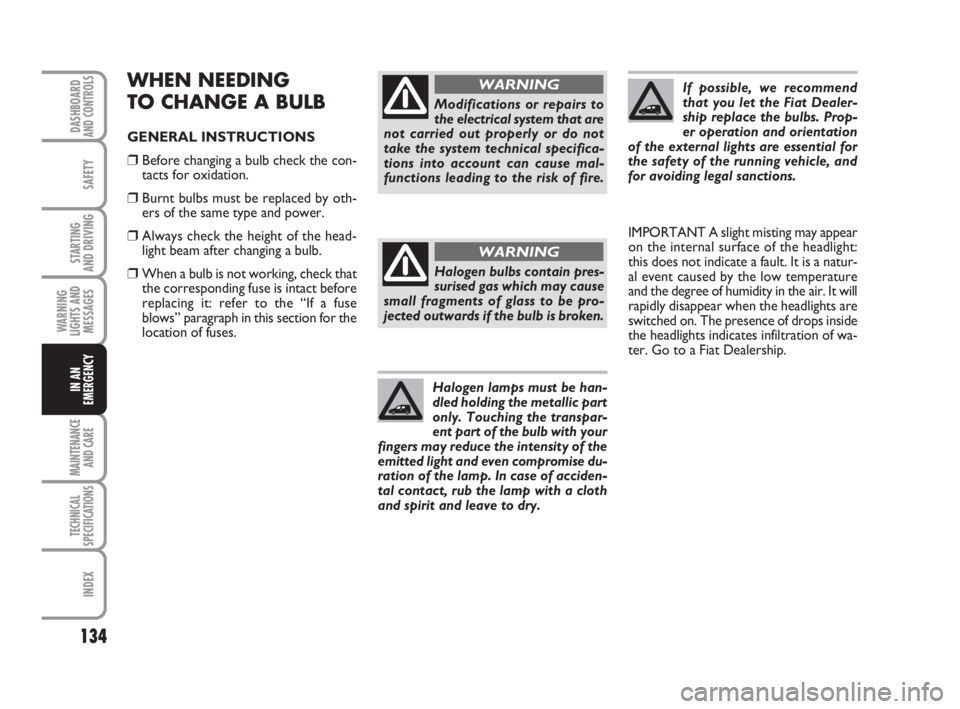
134
SAFETY
MAINTENANCE
AND CARE
TECHNICAL
SPECIFICATIONS
INDEX
DASHBOARDAND CONTROLS
STARTING
AND DRIVING
WARNING
LIGHTS AND
MESSAGES
IN AN
EMERGENCY
WHEN NEEDING
TO CHANGE A BULB
GENERAL INSTRUCTIONS
❒Before changing a bulb check the con-
tacts for oxidation.
❒Burnt bulbs must be replaced by oth-
ers of the same type and power.
❒Always check the height of the head-
light beam after changing a bulb.
❒When a bulb is not working, check that
the corresponding fuse is intact before
replacing it: refer to the “If a fuse
blows” paragraph in this section for the
location of fuses.IMPORTANT A slight misting may appear
on the internal surface of the headlight:
this does not indicate a fault. It is a natur-
al event caused by the low temperature
and the degree of humidity in the air. It will
rapidly disappear when the headlights are
switched on. The presence of drops inside
the headlights indicates infiltration of wa-
ter. Go to a Fiat Dealership.
Modifications or repairs to
the electrical system that are
not carried out properly or do not
take the system technical specifica-
tions into account can cause mal-
functions leading to the risk of fire.
WARNING
Halogen bulbs contain pres-
surised gas which may cause
small fragments of glass to be pro-
jected outwards if the bulb is broken.
WARNING
Halogen lamps must be han-
dled holding the metallic part
only. Touching the transpar-
ent part of the bulb with your
fingers may reduce the intensity of the
emitted light and even compromise du-
ration of the lamp. In case of acciden-
tal contact, rub the lamp with a cloth
and spirit and leave to dry.
If possible, we recommend
that you let the Fiat Dealer-
ship replace the bulbs. Prop-
er operation and orientation
of the external lights are essential for
the safety of the running vehicle, and
for avoiding legal sanctions.
123-154 Fiorino GB 1ed:123-154 Fiorino GB 1ed 3-12-2009 15:33 Pagina 134
Page 136 of 210
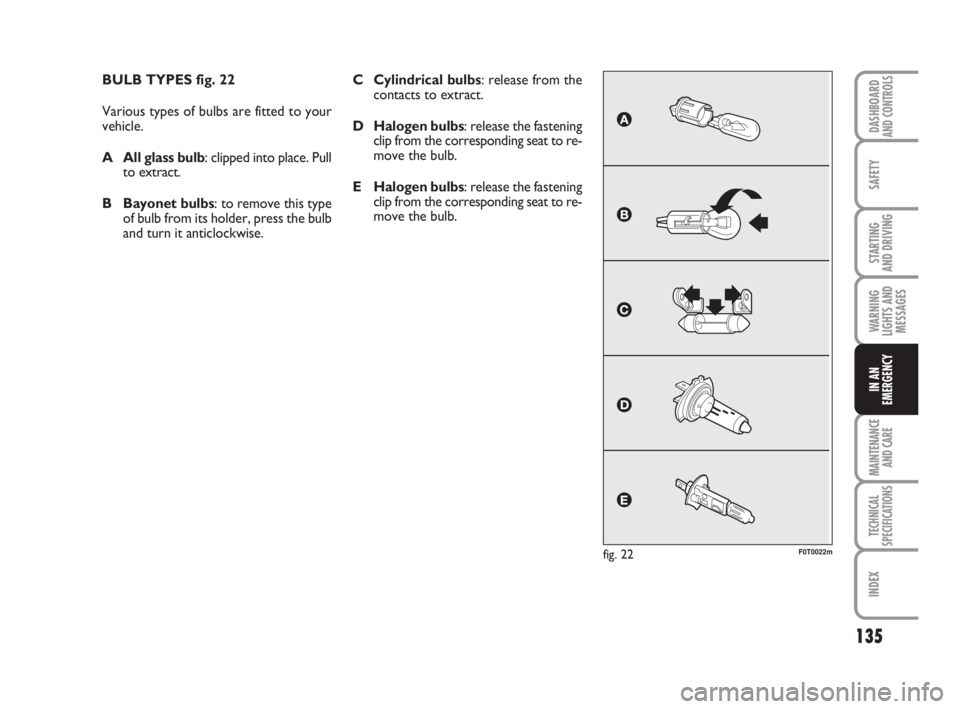
135
SAFETY
MAINTENANCE
AND CARE
TECHNICAL
SPECIFICATIONS
INDEX
DASHBOARDAND CONTROLS
STARTING
AND DRIVING
WARNING
LIGHTS AND
MESSAGES
IN AN
EMERGENCY
BULB TYPES fig. 22
Various types of bulbs are fitted to your
vehicle.
A All glass bulb: clipped into place. Pull
to extract.
B Bayonet bulbs: to remove this type
of bulb from its holder, press the bulb
and turn it anticlockwise.
fig. 22F0T0022m
C Cylindrical bulbs: release from the
contacts to extract.
D Halogen bulbs: release the fastening
clip from the corresponding seat to re-
move the bulb.
E Halogen bulbs: release the fastening
clip from the corresponding seat to re-
move the bulb.
123-154 Fiorino GB 1ed:123-154 Fiorino GB 1ed 3-12-2009 15:33 Pagina 135
Page 148 of 210
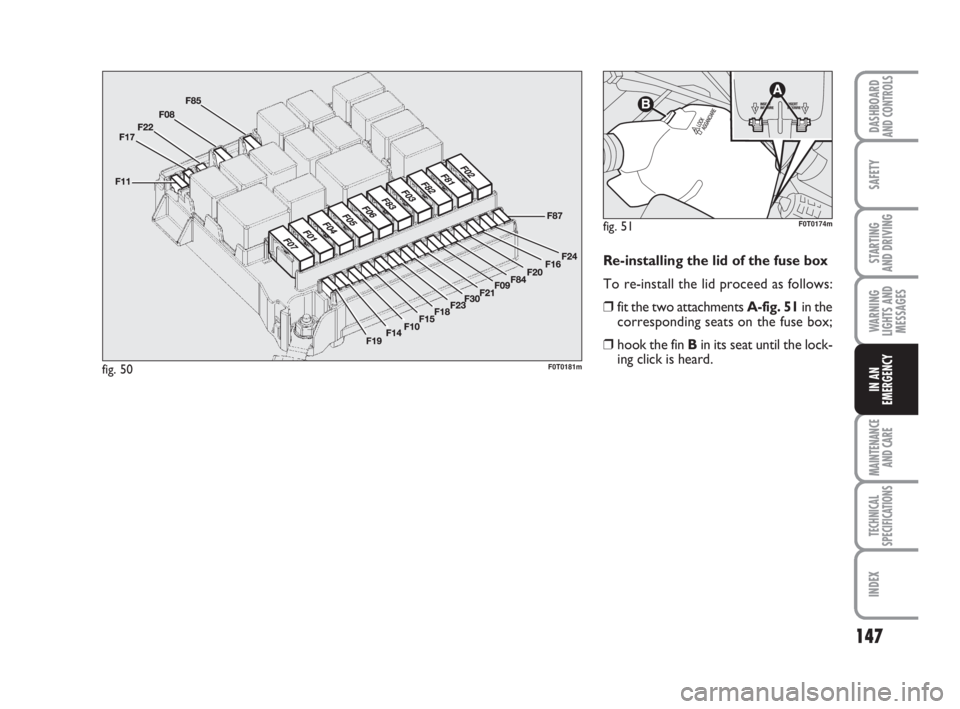
147
SAFETY
MAINTENANCE
AND CARE
TECHNICAL
SPECIFICATIONS
INDEX
DASHBOARDAND CONTROLS
STARTING
AND DRIVING
WARNING
LIGHTS AND
MESSAGES
IN AN
EMERGENCY
Re-installing the lid of the fuse box
To re-install the lid proceed as follows:
❒fit the two attachments A-fig. 51in the
corresponding seats on the fuse box;
❒hook the fin Bin its seat until the lock-
ing click is heard.
fig. 50F0T0181m
fig. 51F0T0174m
123-154 Fiorino GB 1ed:123-154 Fiorino GB 1ed 3-12-2009 15:33 Pagina 147
Page 155 of 210
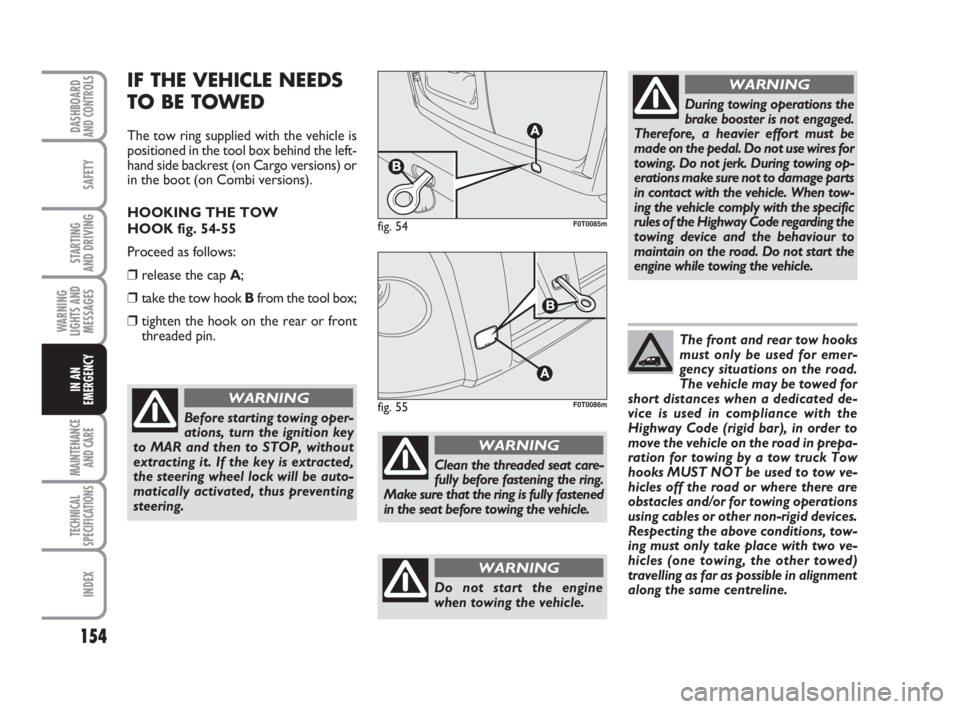
154
SAFETY
MAINTENANCE
AND CARE
TECHNICAL
SPECIFICATIONS
INDEX
DASHBOARDAND CONTROLS
STARTING
AND DRIVING
WARNING
LIGHTS AND
MESSAGES
IN AN
EMERGENCY
IF THE VEHICLE NEEDS
TO BE TOWED
The tow ring supplied with the vehicle is
positioned in the tool box behind the left-
hand side backrest (on Cargo versions) or
in the boot (on Combi versions).
HOOKING THE TOW
HOOK fig. 54-55
Proceed as follows:
❒release the cap A;
❒take the tow hook Bfrom the tool box;
❒tighten the hook on the rear or front
threaded pin.
fig. 54F0T0085m
fig. 55F0T0086m
Before starting towing oper-
ations, turn the ignition key
to MAR and then to STOP, without
extracting it. If the key is extracted,
the steering wheel lock will be auto-
matically activated, thus preventing
steering.
WARNING
During towing operations the
brake booster is not engaged.
Therefore, a heavier effort must be
made on the pedal. Do not use wires for
towing. Do not jerk. During towing op-
erations make sure not to damage parts
in contact with the vehicle. When tow-
ing the vehicle comply with the specific
rules of the Highway Code regarding the
towing device and the behaviour to
maintain on the road. Do not start the
engine while towing the vehicle.
WARNING
Clean the threaded seat care-
fully before fastening the ring.
Make sure that the ring is fully fastened
in the seat before towing the vehicle.
WARNING
Do not start the engine
when towing the vehicle.
WARNING
The front and rear tow hooks
must only be used for emer-
gency situations on the road.
The vehicle may be towed for
short distances when a dedicated de-
vice is used in compliance with the
Highway Code (rigid bar), in order to
move the vehicle on the road in prepa-
ration for towing by a tow truck Tow
hooks MUST NOT be used to tow ve-
hicles off the road or where there are
obstacles and/or for towing operations
using cables or other non-rigid devices.
Respecting the above conditions, tow-
ing must only take place with two ve-
hicles (one towing, the other towed)
travelling as far as possible in alignment
along the same centreline.
123-154 Fiorino GB 1ed:123-154 Fiorino GB 1ed 3-12-2009 15:34 Pagina 154
Page 164 of 210
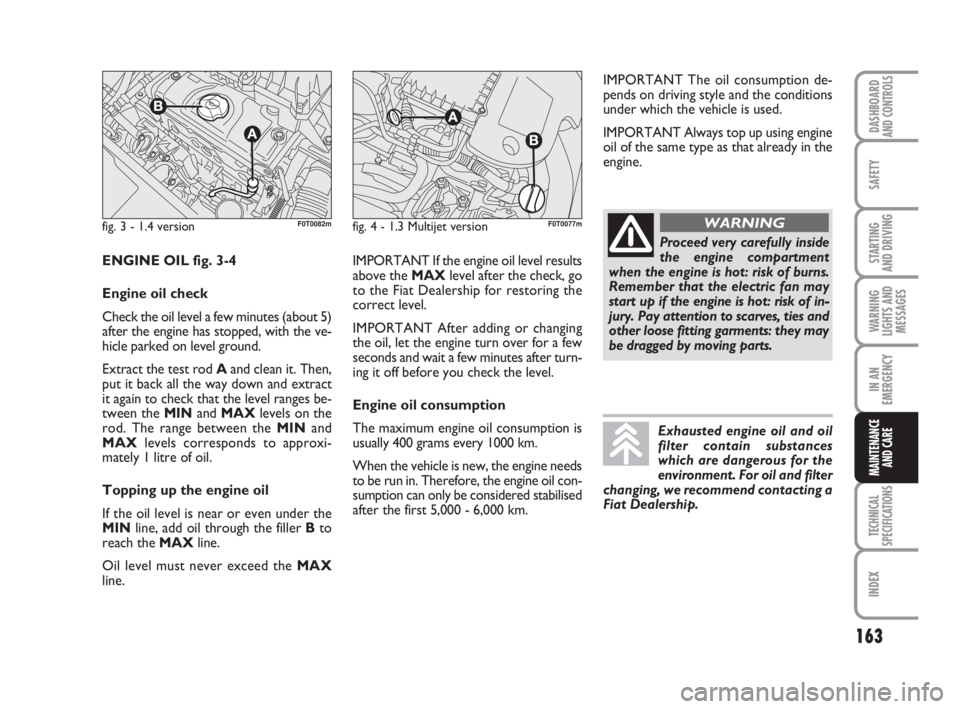
163
SAFETY
TECHNICAL
SPECIFICATIONS
INDEX
DASHBOARDAND CONTROLS
STARTING
AND DRIVING
WARNING
LIGHTS AND
MESSAGES
IN AN
EMERGENCY
MAINTENANCE
AND CARE
fig. 3 - 1.4 versionF0T0082mfig. 4 - 1.3 Multijet versionF0T0077m
IMPORTANT The oil consumption de-
pends on driving style and the conditions
under which the vehicle is used.
IMPORTANT Always top up using engine
oil of the same type as that already in the
engine.
ENGINE OIL fig. 3-4
Engine oil check
Check the oil level a few minutes (about 5)
after the engine has stopped, with the ve-
hicle parked on level ground.
Extract the test rod Aand clean it. Then,
put it back all the way down and extract
it again to check that the level ranges be-
tween the MINand MAXlevels on the
rod. The range between the MINand
MAXlevels corresponds to approxi-
mately 1 litre of oil.
Topping up the engine oil
If the oil level is near or even under the
MINline, add oil through the filler Bto
reach the MAXline.
Oil level must never exceed the MAX
line.
Proceed very carefully inside
the engine compartment
when the engine is hot: risk of burns.
Remember that the electric fan may
start up if the engine is hot: risk of in-
jury. Pay attention to scarves, ties and
other loose fitting garments: they may
be dragged by moving parts.
WARNING
Exhausted engine oil and oil
filter contain substances
which are dangerous for the
environment. For oil and filter
changing, we recommend contacting a
Fiat Dealership.
IMPORTANT If the engine oil level results
above the MAXlevel after the check, go
to the Fiat Dealership for restoring the
correct level.
IMPORTANT After adding or changing
the oil, let the engine turn over for a few
seconds and wait a few minutes after turn-
ing it off before you check the level.
Engine oil consumption
The maximum engine oil consumption is
usually 400 grams every 1000 km.
When the vehicle is new, the engine needs
to be run in. Therefore, the engine oil con-
sumption can only be considered stabilised
after the first 5,000 - 6,000 km.
155-176 Fiorino GB 1ed:155-176 Fiorino GB 1ed 30-11-2009 16:34 Pagina 163
Page 175 of 210
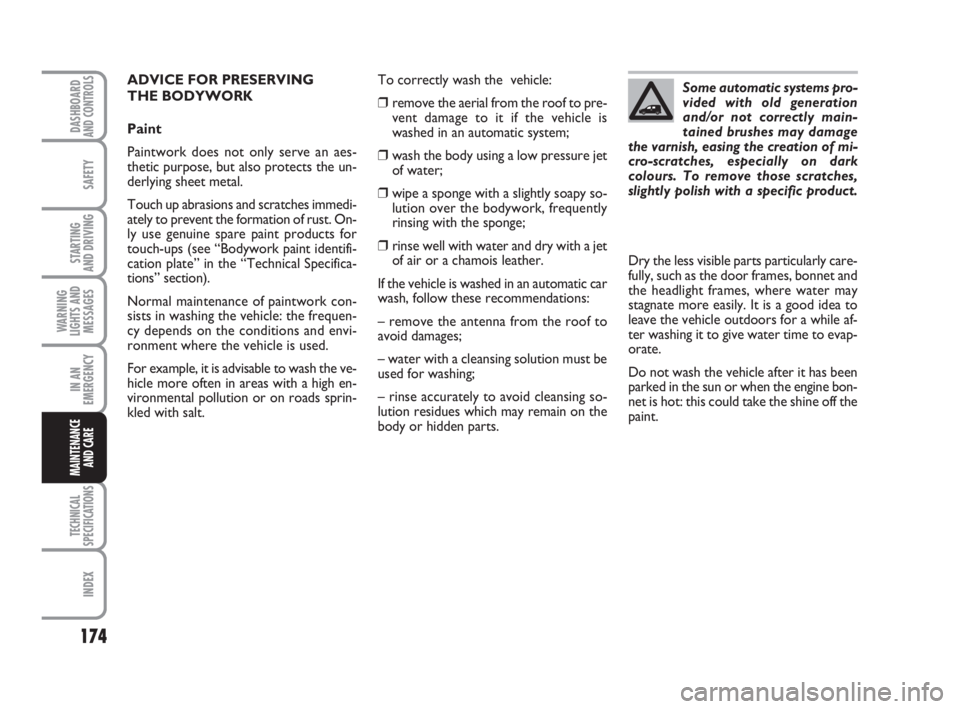
174
SAFETY
TECHNICAL
SPECIFICATIONS
INDEX
DASHBOARDAND CONTROLS
STARTING
AND DRIVING
WARNING
LIGHTS AND
MESSAGES
IN AN
EMERGENCY
MAINTENANCE
AND CARE
ADVICE FOR PRESERVING
THE BODYWORK
Paint
Paintwork does not only serve an aes-
thetic purpose, but also protects the un-
derlying sheet metal.
Touch up abrasions and scratches immedi-
ately to prevent the formation of rust. On-
ly use genuine spare paint products for
touch-ups (see “Bodywork paint identifi-
cation plate” in the “Technical Specifica-
tions” section).
Normal maintenance of paintwork con-
sists in washing the vehicle: the frequen-
cy depends on the conditions and envi-
ronment where the vehicle is used.
For example, it is advisable to wash the ve-
hicle more often in areas with a high en-
vironmental pollution or on roads sprin-
kled with salt.To correctly wash the vehicle:
❒remove the aerial from the roof to pre-
vent damage to it if the vehicle is
washed in an automatic system;
❒wash the body using a low pressure jet
of water;
❒wipe a sponge with a slightly soapy so-
lution over the bodywork, frequently
rinsing with the sponge;
❒rinse well with water and dry with a jet
of air or a chamois leather.
If the vehicle is washed in an automatic car
wash, follow these recommendations:
– remove the antenna from the roof to
avoid damages;
– water with a cleansing solution must be
used for washing;
– rinse accurately to avoid cleansing so-
lution residues which may remain on the
body or hidden parts.Dry the less visible parts particularly care-
fully, such as the door frames, bonnet and
the headlight frames, where water may
stagnate more easily. It is a good idea to
leave the vehicle outdoors for a while af-
ter washing it to give water time to evap-
orate.
Do not wash the vehicle after it has been
parked in the sun or when the engine bon-
net is hot: this could take the shine off the
paint.Some automatic systems pro-
vided with old generation
and/or not correctly main-
tained brushes may damage
the varnish, easing the creation of mi-
cro-scratches, especially on dark
colours. To remove those scratches,
slightly polish with a specific product.
155-176 Fiorino GB 1ed:155-176 Fiorino GB 1ed 30-11-2009 16:34 Pagina 174
Page 179 of 210
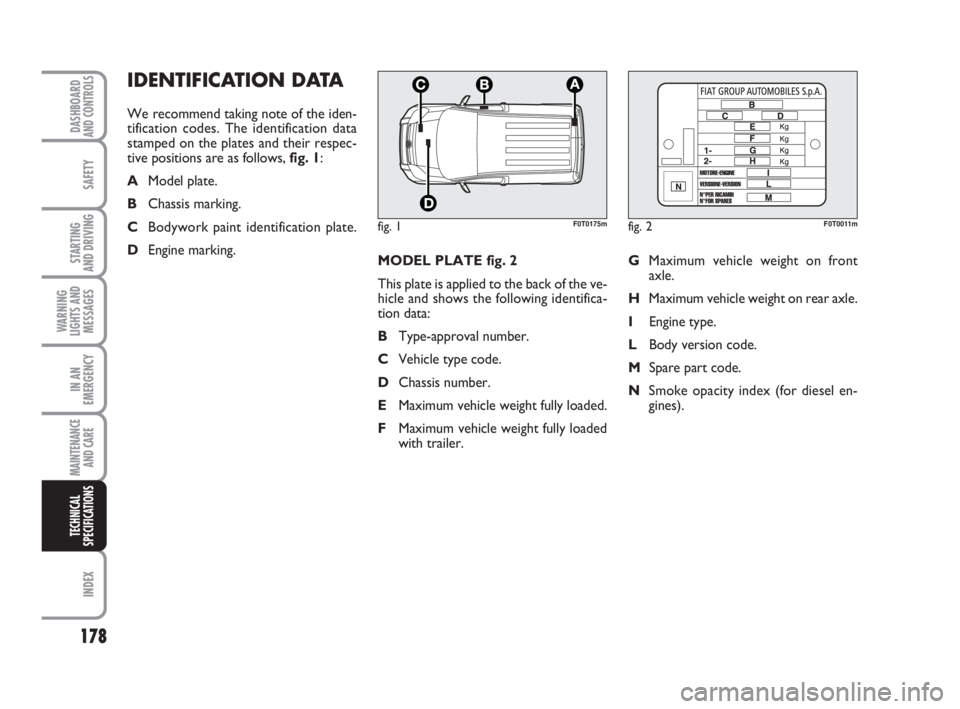
178
SAFETY
INDEX
DASHBOARDAND CONTROLS
STARTING
AND DRIVING
WARNING
LIGHTS AND
MESSAGES
IN AN
EMERGENCY
MAINTENANCE
AND CARE
TECHNICAL
SPECIFICATIONS
MODEL PLATE fig. 2
This plate is applied to the back of the ve-
hicle and shows the following identifica-
tion data:
BType-approval number.
CVehicle type code.
DChassis number.
EMaximum vehicle weight fully loaded.
FMaximum vehicle weight fully loaded
with trailer.GMaximum vehicle weight on front
axle.
HMaximum vehicle weight on rear axle.
IEngine type.
LBody version code.
MSpare part code.
NSmoke opacity index (for diesel en-
gines).
IDENTIFICATION DATA
We recommend taking note of the iden-
tification codes. The identification data
stamped on the plates and their respec-
tive positions are as follows, fig. 1:
AModel plate.
BChassis marking.
CBodywork paint identification plate.
DEngine marking.
fig. 1F0T0175mfig. 2F0T0011m
177-199 Fiorino GB 1ed:177-201 Fiorino GB 1ed 4-12-2009 9:42 Pagina 178
Page 182 of 210
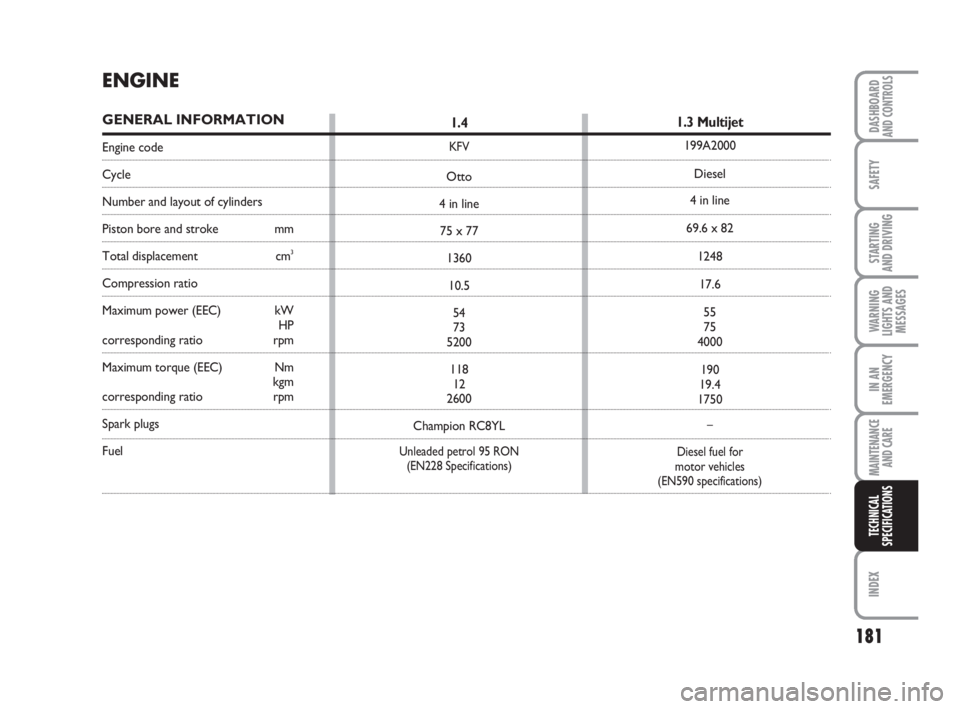
181
SAFETY
INDEX
DASHBOARDAND CONTROLS
STARTING
AND DRIVING
WARNING
LIGHTS AND
MESSAGES
IN AN
EMERGENCY
MAINTENANCE
AND CARE
TECHNICAL
SPECIFICATIONS
ENGINE
GENERAL INFORMATION
Engine code
Cycle
Number and layout of cylinders
Piston bore and stroke mm
Total displacement cm3
Compression ratio
Maximum power (EEC) kW
HP
corresponding ratio rpm
Maximum torque (EEC) Nm
kgm
corresponding ratio rpm
Spark plugs
Fuel
1.4
KFV
Otto
4 in line
75 x 77
1360
10.5
54
73
5200
118
12
2600
Champion RC8YL
Unleaded petrol 95 RON
(EN228 Specifications)
1.3 Multijet
199A2000
Diesel
4 in line
69.6 x 82
1248
17.6
55
75
4000
190
19.4
1750
–
Diesel fuel for
motor vehicles
(EN590 specifications)
177-199 Fiorino GB 1ed:177-201 Fiorino GB 1ed 4-12-2009 9:42 Pagina 181
Page 185 of 210

184
SAFETY
INDEX
DASHBOARDAND CONTROLS
STARTING
AND DRIVING
WARNING
LIGHTS AND
MESSAGES
IN AN
EMERGENCY
MAINTENANCE
AND CARE
TECHNICAL
SPECIFICATIONS
UNDERSTANDING
TYRE MARKING fig. 5
Example: 175/70 R 14 91T
175= Nominal width (S, distance in mm
between sidewalls).
70= Height/width ratio (H/S) in per-
centage.
R= Radial tyre.
14= Rim diameter in inches (Ø).
91= Load rating (capacity).
T= Maximum speed rating.
WHEELS
RIMS AND TYRES
Pressed steel or alloy rims. Tubeless ra-
dial carcass tyres. All approved tyres are
listed in the Log Book.
IMPORTANT In the event of discrepan-
cies between the information provided on
this “Owner handbook” and the “Log
book”, consider the specifications shown
in the log book only.
Respect the prescribed size to ensure
safety of the vehicle in movement. Fit tyres
of the same make and type on all wheels.
IMPORTANT Do not use inner tubes
with Tubeless tyres.
SPARE WHEEL
Pressed steel rim Tubeless tyre.
WHEEL GEOMETRY
Toe-in measured between rims: –1 ±1
mm.
The values refer to the vehicle in running
order.
fig. 5F0T0014m
Load rating (capacity)
60= 250 kg 84= 500 kg
61= 257 kg 85= 515 kg
62= 265 kg 86= 530 kg
63= 272 kg 87= 545 kg
64= 280 kg 88= 560 kg
65= 290 kg 89= 580 kg
66= 300 kg 90= 600 kg
67= 307 kg 91= 615 kg
68= 315 kg 92= 630 kg
69= 325 kg 93= 650 kg
70= 335 kg 94= 670 kg
71= 345 kg 95= 690 kg
72= 355 kg 96= 710 kg
73= 365 kg 97= 730 kg
74= 375 kg 98= 750 kg
75= 387 kg 99= 775 kg
76= 400 kg 100= 800 kg
77= 412 kg 101= 825 kg
78= 425 kg 102= 850 kg
79= 437 kg 103= 875 kg
80= 450 kg 104= 900 kg
81= 462 kg 105= 925 kg
82= 475 kg 106= 950 kg
83= 487 kg
177-199 Fiorino GB 1ed:177-201 Fiorino GB 1ed 4-12-2009 9:42 Pagina 184